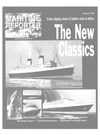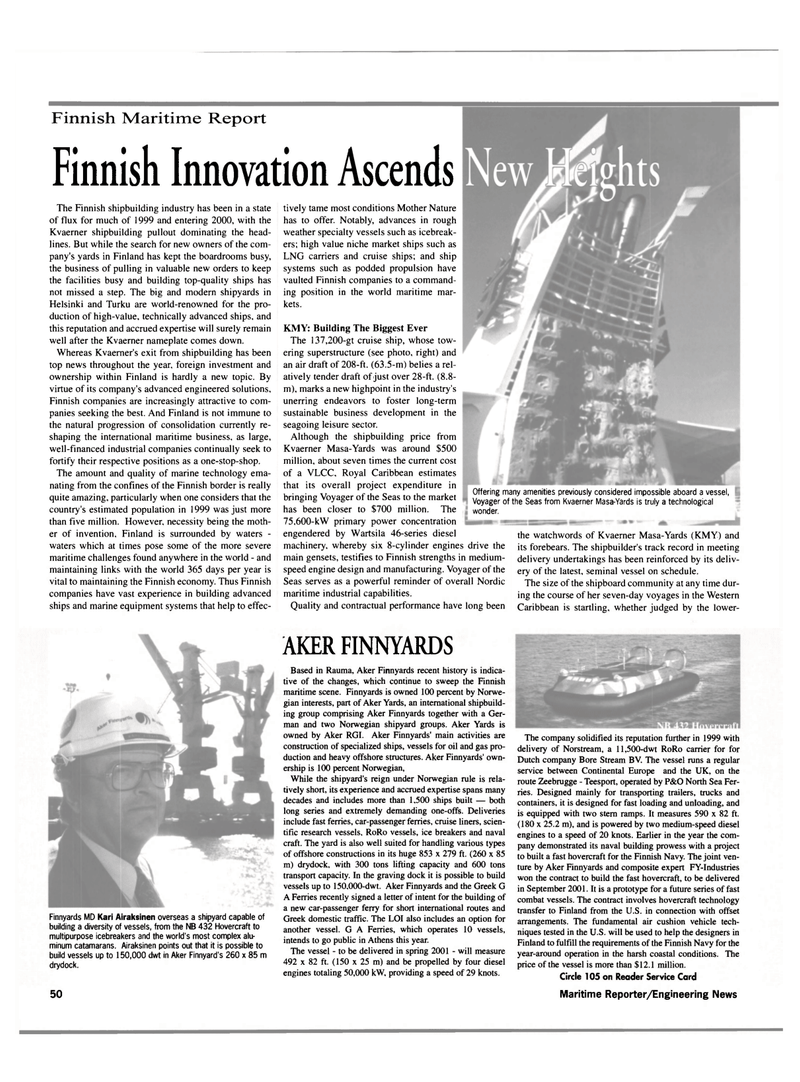
Page 50: of Maritime Reporter Magazine (February 2000)
Read this page in Pdf, Flash or Html5 edition of February 2000 Maritime Reporter Magazine
Finnish Maritime Report
Finnish Innovation Ascends
The Finnish shipbuilding industry has been in a state of flux for much of 1999 and entering 2000, with the
Kvaerner shipbuilding pullout dominating the head- lines. But while the search for new owners of the com- pany's yards in Finland has kept the boardrooms busy, the business of pulling in valuable new orders to keep the facilities busy and building top-quality ships has not missed a step. The big and modern shipyards in
Helsinki and Turku are world-renowned for the pro- duction of high-value, technically advanced ships, and this reputation and accrued expertise will surely remain well after the Kvaerner nameplate comes down.
Whereas Kvaemer's exit from shipbuilding has been top news throughout the year, foreign investment and ownership within Finland is hardly a new topic. By virtue of its company's advanced engineered solutions,
Finnish companies are increasingly attractive to com- panies seeking the best. And Finland is not immune to the natural progression of consolidation currently re- shaping the international maritime business, as large, well-financed industrial companies continually seek to fortify their respective positions as a one-stop-shop.
The amount and quality of marine technology ema- nating from the confines of the Finnish border is really quite amazing, particularly when one considers that the country's estimated population in 1999 was just more than five million. However, necessity being the moth- er of invention, Finland is surrounded by waters - waters which at times pose some of the more severe maritime challenges found anywhere in the world - and maintaining links with the world 365 days per year is vital to maintaining the Finnish economy. Thus Finnish companies have vast experience in building advanced ships and marine equipment systems that help to effec- tively tame most conditions Mother Nature has to offer. Notably, advances in rough weather specialty vessels such as icebreak- ers; high value niche market ships such as
LNG carriers and cruise ships; and ship systems such as podded propulsion have vaulted Finnish companies to a command- ing position in the world maritime mar- kets.
Finnyards MD Kari Airaksinen overseas a shipyard capable of building a diversity of vessels, from the NB 432 Hovercraft to multipurpose icebreakers and the world's most complex alu- minum catamarans. Airaksinen points out that it is possible to build vessels up to 150,000 dwt in Aker Finnyard's 260 x 85 m drydock.
AKER FINNYARDS
Based in Rauma, Aker Finnyards recent history is indica- tive of the changes, which continue to sweep the Finnish maritime scene. Finnyards is owned 100 percent by Norwe- gian interests, part of Aker Yards, an international shipbuild- ing group comprising Aker Finnyards together with a Ger- man and two Norwegian shipyard groups. Aker Yards is owned by Aker RGI. Aker Finnyards' main activities are construction of specialized ships, vessels for oil and gas pro- duction and heavy offshore structures. Aker Finnyards' own- ership is 100 percent Norwegian,
While the shipyard's reign under Norwegian rule is rela- tively short, its experience and accrued expertise spans many decades and includes more than 1.500 ships built — both long series and extremely demanding one-offs. Deliveries include fast ferries, car-passenger ferries, cruise liners, scien- tific research vessels, RoRo vessels, ice breakers and naval craft. The yard is also well suited for handling various types of offshore constructions in its huge 853 x 279 ft. (260 x 85 m) drydock, with 300 tons lifting capacity and 600 tons transport capacity. In the graving dock it is possible to build vessels up to 150,000-dwt. Aker Finnyards and the Greek G
A Ferries recently signed a letter of intent for the building of a new car-passenger ferry for short international routes and
Greek domestic traffic. The LOI also includes an option for another vessel. G A Ferries, which operates 10 vessels, intends to go public in Athens this year.
The vessel - to be delivered in spring 2001 - will measure 492 x 82 ft. (150 x 25 m) and be propelled by four diesel engines totaling 50,000 kW, providing a speed of 29 knots.
The company solidified its reputation further in 1999 with delivery of Norstream, a 11,500-dwt RoRo carrier for for
Dutch company Bore Stream BV. The vessel runs a regular service between Continental Europe and the UK, on the route Zeebrugge - Teesport, operated by P&O North Sea Fer- ries. Designed mainly for transporting trailers, trucks and containers, it is designed for fast loading and unloading, and is equipped with two stern ramps. It measures 590 x 82 ft. (180 x 25.2 m), and is powered by two medium-speed diesel engines to a speed of 20 knots. Earlier in the year the com- pany demonstrated its naval building prowess with a project to built a fast hovercraft for the Finnish Navy. The joint ven- ture by Aker Finnyards and composite expert FY-Industries won the contract to build the fast hovercraft, to be delivered in September 2001. It is a prototype for a future series of fast combat vessels. The contract involves hovercraft technology transfer to Finland from the U.S. in connection with offset arrangements. The fundamental air cushion vehicle tech- niques tested in the U.S. will be used to help the designers in
Finland to fulfill the requirements of the Finnish Navy for the year-around operation in the harsh coastal conditions. The price of the vessel is more than $12.1 million.
Circle 105 on Reader Service Card
KMY: Building The Biggest Ever
The 137,200-gt cruise ship, whose tow- ering superstructure (see photo, right) and an air draft of 208-ft. (63.5-m) belies a rel- atively tender draft of just over 28-ft. (8.8- m), marks a new highpoint in the industry's unerring endeavors to foster long-term sustainable business development in the seagoing leisure sector.
Although the shipbuilding price from
Kvaerner Masa-Yards was around $500 million, about seven times the current cost of a VLCC, Royal Caribbean estimates that its overall project expenditure in bringing Voyager of the Seas to the market has been closer to $700 million. The 75.600-kW primary power concentration engendered by Wartsila 46-series diesel machinery, whereby six 8-cylinder engines drive the main gensets, testifies to Finnish strengths in medium- speed engine design and manufacturing. Voyager of the
Seas serves as a powerful reminder of overall Nordic maritime industrial capabilities.
Quality and contractual performance have long been
Offering many amenities previously considered impossible aboard a vessel,
Voyager of the Seas from Kvaerner Masa-Yards is truly a technological wonder. the watchwords of Kvaerner Masa-Yards (KMY) and its forebears. The shipbuilder's track record in meeting delivery undertakings has been reinforced by its deliv- ery of the latest, seminal vessel on schedule.
The size of the shipboard community at any time dur- ing the course of her seven-day voyages in the Western
Caribbean is startling, whether judged by the lower- 50 Maritime Reporter/Engineering News

 49
49

 51
51
